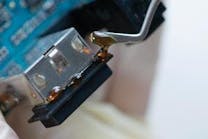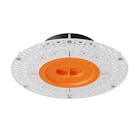Date Announced: 17 Nov 2008 Sign companies report decline in neon due to energy and maintenance savings of LED. The letters still glow bright red, but ComEd's prominent sign atop its Oakbrook Terrace headquarters has gone green. The electric utility recently completed replacing the sign's old neon illumination with LED lights that consume nearly 90 percent less energy, last longer, and require less maintenance. Visible to drivers along Interstate 88, the old signage previously used 2,618-watt neon lights, but now generate the same brightness using 323-watt LEDs (light-emitting diodes). Because LEDs also last longer than neon lights and need to be replaced less frequently, ComEd expects to save another 20 percent in annual maintenance costs. This change to energy-efficient lighting is one of many that ComEd recommends to its business and residential customers to reduce energy costs and minimize environmental effects. Many of these suggestions can be found at http://www.ComEd.com. "The benefits of energy-efficient lighting are just too significant to ignore," said Val Jensen, ComEd vice president of Marketing & Environmental Programs. "For ComEd, the saying 'Go Green, Save Green' is not just an advertising slogan. We hope our example spurs all customers -- business and residential -- to explore the many ways they can become leaner and greener." ComEd contracts for its signs and sign maintenance through Lombard, Ill.-based Olympic Signs. Olympic President Rob Whitehead said the shift away from neon is part of a major nationwide trend, and LED-lit signs have quickly become the industry standard for roadside advertisements and storefront displays. "We are seeing a huge increase in LED use. All of the large outlets are moving towards or have already converted to LEDs, such as McDonalds, Best Buy, and Bank of America," Whitehead said. "Because LEDs function at a lower voltage, they are also considered safer, and in cold weather, they illuminate with a more consistent brightness than outdoor neon lights that may falter due to the cold or low temperatures." The change to LEDs is also part of ComEd's environmental initiatives that support Exelon 2020, a comprehensive strategy announced earlier this year by Exelon, ComEd's parent company. The goal of Exelon 2020 is to reduce, offset or displace more than 15 million metric tons of greenhouse gas emitted by its family of companies and customers. This includes ComEd's efforts to reduce its energy consumption by 25 percent by 2012. ComEd has been conducting energy audits at more than 50 of its locations across Northern Illinois. These audits have already prompted retrofitting some locations with energy-efficient overhead lighting, installing occupancy sensors, and improving HVAC systems. ComEd also operates one of the largest private fleets of biodiesel vehicles, with all of its diesel engines-more than 2,000-now operating on biodiesel fuel. This has reduced ComEd's emission of carbon dioxide by more than 1,400 metric tons each year, which is the equivalent of taking 100 utility trucks, or 300 compact cars, off the road per year.ComEd has installed LEDs on the south- and east-facing signs atop 2 Lincoln Centre, a 10-story building at 22nd Street and Butterfield Road in Oakbrook Terrace. Commonwealth Edison Company (ComEd) is a unit of Chicago-based Exelon Corporation, one of the nation's largest electric utilities with approximately 5.4 million customers. ComEd provides service to approximately 3.8 million customers across Northern Illinois, or 70 percent of the state's population. Caption: Atop the 10th floor of ComEd's Oakbrook Terrace headquarters at 22nd Street and Butterfield Road, Dan Martin of Olympic Signs replaces neon signage with new LED lights that are nearly 90 percent more energy efficient.
Contact
Jeff Burdick ComEd Media Relations
E-mail:[email protected]
Web Site:www.ComEd.com






